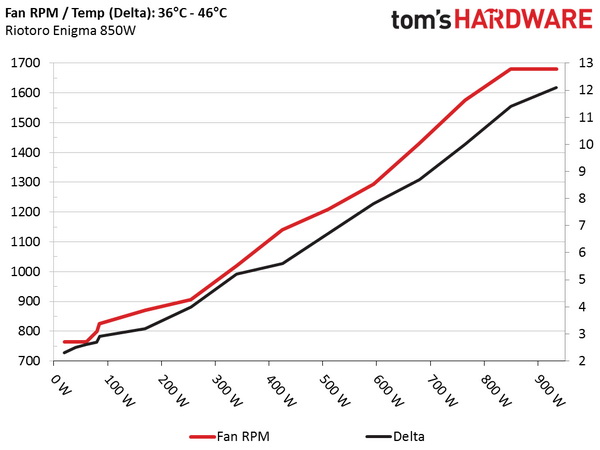Riotoro Enigma 850W PSU Review
Riotoro is a newly founded company that's currently involved in the PSU, chassis, cooling, and gaming peripheral markets. It only has two PSU lines with three total members, and today we're looking at the Enigma 850W, its flagship offering.
Why you can trust Tom's Hardware
Efficiency, Temperature, And Noise
Efficiency
Our efficiency testing procedure is detailed here.
Using the results from the previous page, we plotted a chart showing the Enigma 850's efficiency at low loads, and loads from 10 to 110 percent of its maximum-rated capacity.
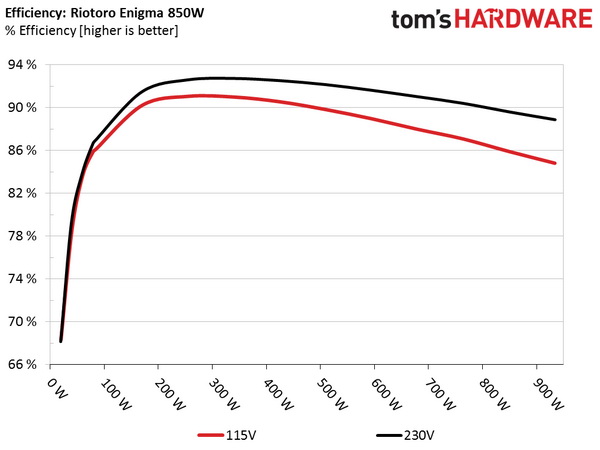

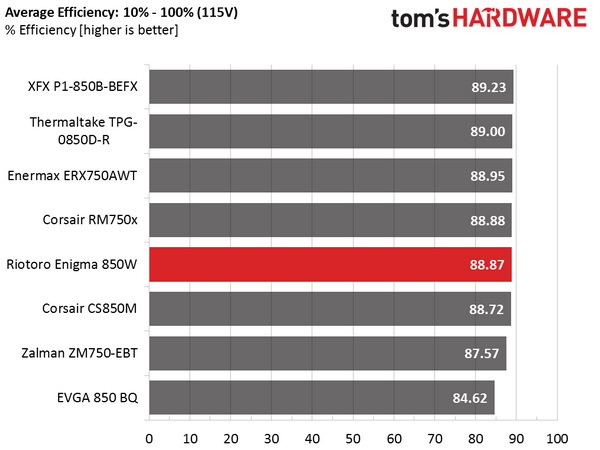
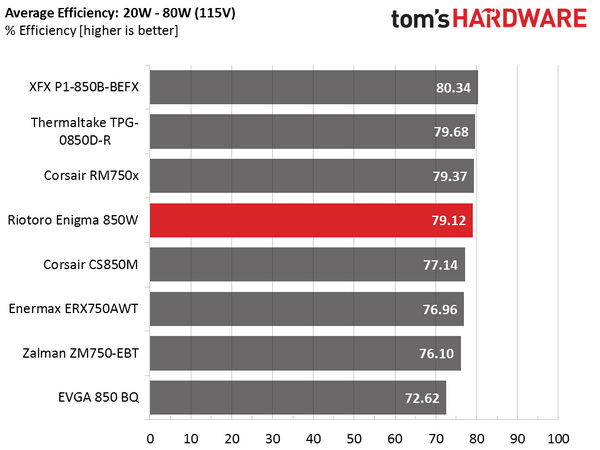
The PSU's efficiency is normal for an 850W Gold-rated model. As you can see, the efficiency differences between Riotoro's offering and Corsair's CS850M, based on the same platform, are minimal.
Efficiency At Low Loads
In the following tests, we measure the efficiency of the Enigma 850W at loads significantly lower than 10 percent of its maximum capacity (the lowest load the 80 PLUS standard measures). The loads we dialed were 20, 40, 60, and 80W. This is important for representing when a PC is idle, with power-saving features turned on.
| Test # | 12V | 5V | 3.3V | 5VSB | DC/AC (Watts) | Efficiency | Fan Speed | Fan Noise | PF/AC Volts |
|---|---|---|---|---|---|---|---|---|---|
| 1 | 1.206A | 0.491A | 0.476A | 0.194A | 19.67 | 68.321% | 765 RPM | 23.4 dB(A) | 0.876 |
| 12.102V | 5.098V | 3.347V | 5.046V | 28.79 | 115.11V | ||||
| 2 | 2.439A | 0.980A | 0.984A | 0.396A | 39.78 | 78.535% | 765 RPM | 23.4 dB(A) | 0.921 |
| 12.097V | 5.093V | 3.344V | 5.036V | 50.65 | 115.06V | ||||
| 3 | 3.672A | 1.466A | 1.495A | 5.028A | 59.86 | 83.674% | 765 RPM | 23.4 dB(A) | 0.964 |
| 12.095V | 5.088V | 3.341V | 5.028V | 71.54 | 115.05V | ||||
| 4 | 4.889A | 1.964A | 1.973A | 0.796A | 79.73 | 85.933% | 800 RPM | 25.0 dB(A) | 0.956 |
| 12.101V | 5.083V | 3.338V | 5.017V | 92.78 | 115.05V |
We would like to see greater than 70% efficiency with 20W load. Results in the other three tests are satisfactory, given the PSU's high capacity.
5VSB Efficiency
The ATX specification states that 5VSB standby supply efficiency should be as high as possible, recommending 50 percent or higher with 100mA of load, 60 percent or higher with 250mA of load, and 70 percent or higher with 1A or more of load.
We take four measurements: one each at 100, 250, and 1000mA, and one with the full load the 5VSB rail can handle.
Get Tom's Hardware's best news and in-depth reviews, straight to your inbox.
| Test # | 5VSB | DC/AC (Watts) | Efficiency | PF/AC Volts |
|---|---|---|---|---|
| 1 | 0.101A | 0.510 | 78.462% | 0.063 |
| 5.048V | 0.650 | 115.12V | ||
| 2 | 0.251A | 1.266 | 82.208% | 0.139 |
| 5.042V | 1.540 | 115.12V | ||
| 3 | 1.002A | 5.021 | 83.350% | 0.329 |
| 5.011V | 6.024 | 115.12V | ||
| 4 | 3.002A | 14.803 | 79.586% | 0.449 |
| 4.931V | 18.600 | 115.13V |
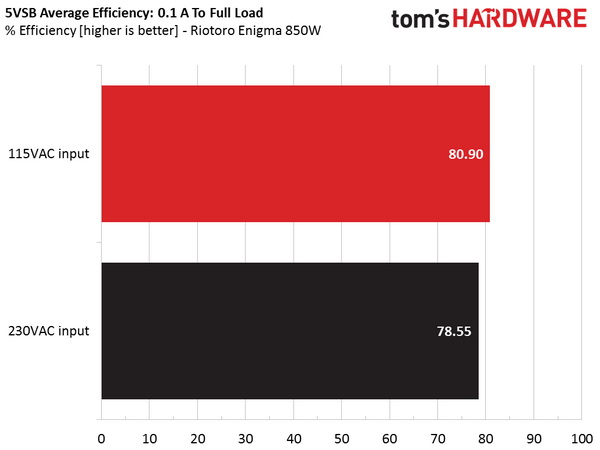

The 5VSB rail is much more efficient than the one in Corsair's CS850M.
Power Consumption In Idle And Standby
In the table below, you'll find the power consumption and voltage values of all rails (except -12V) when the PSU is idle (powered on, but without any load on its rails), and the power consumption when the PSU is in standby mode (without any load, at 5VSB).
| Mode | 12V | 5V | 3.3V | 5VSB | Watts | PF/AC Volts |
|---|---|---|---|---|---|---|
| Idle | 12.123V | 5.106V | 3.353V | 5.052V | 8.483 | 0.555 |
| 115.1V | ||||||
| Standby | 0.054 | 0.005 | ||||
| 115.1V |

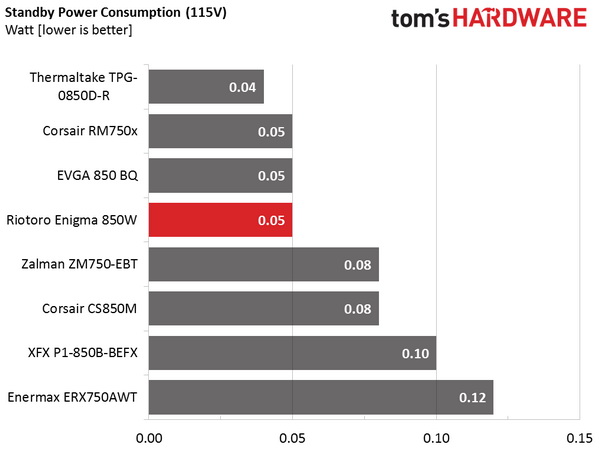
Vampire power is very low. Surely this helps improve the 5VSB rail's efficiency, especially under light loads.
Fan RPM, Delta Temperature, And Output Noise
Our mixed noise testing is described in detail here.
The first chart below illustrates the cooling fan's speed (in RPM), and the delta between input and output temperature. The results were obtained at 36°C (96.8°F) to 46°C (114.8°F) ambient temperature.
The next chart shows the cooling fan's speed (again, in RPM) and output noise. We measured acoustics from one meter away, inside a small, custom-made anechoic chamber with internals completely covered in sound-proofing material (be quiet! Noise Absorber kit). Background noise inside the chamber was below 18 dB(A) during testing, and the results were obtained with the PSU operating at 36°C (96.8°F) to 46°C (114.8°F) ambient temperature.
The following graph illustrates the fan's output noise over the PSU's operating range. The same conditions of the above graph apply to our measurements, though the ambient temperature was between at 30°C (86°F) to 32°C (89.6°F).
With up to around 330W load at +12V, noise output is low. You need to pull more than 600W in order for the fan to start spinning faster, at which point it generates more than 37 dB(A) of noise. Up above 800W, the noise level exceeds 40 dB(A).
At normal ambient temperatures, the PSU runs silently up to typical load levels. It's only when you push the Enigma that it gets louder. And even then, you probably won't find it annoying.
Current page: Efficiency, Temperature, And Noise
Prev Page Load Regulation, Hold-Up Time, And Inrush Current Next Page Protection Features, Evaluated
Aris Mpitziopoulos is a contributing editor at Tom's Hardware, covering PSUs.
-
Pompompaihn Enigma is a HORRIBLE name for the one part in your computer you want to always work exactly as specified and never outside of those specs....Reply -
zthomas 850 will power a normal system.. but thinking VR or a second video card.. 850 ain't enough.. I just upgraded from a 700 to a 1200.. why go small, go larger.. you run a 900 series.. you want a punch.. not a lag..Reply -
maxwellmelon A mov can be a blessing and a curse. When the MOV eventually fails it offers no protection (and there is no indicator on it to indicate failure) then after awhile it will form into a short at which point the psu will fail to work due to a short on the incoming mains. so your MOV will can extend the life by protecting the psu. but in the end it will be the end of the psu. In a lot of ways it is still better to get a good surge protector with MOV protection inside of it because they actually have an indicator to let you know the MOV has failed and you can actually replace the surge protector..If the MOV has failed in the psu you will never know and even if you did know the whole PSU has to be replaced. a good surge protector is still cheaper to replace then the psu.Reply -
anbello262 Reply19366477 said:850 will power a normal system.. but thinking VR or a second video card.. 850 ain't enough.. I just upgraded from a 700 to a 1200.. why go small, go larger.. you run a 900 series.. you want a punch.. not a lag..
I actually don't agree with you at all. 850w is enough for almost any system with even 1080 SLI, and VR doesn't actually require more power by itself (only requires power by high utilization of your system).
So for almost anyone, 650w is more than enough even for high end systems, and if you want to SLI high end cards, then 850W is advisable.
More than that is overkill in almost all cases, in my (somewhat informed) opinion.
Having a good quality PSU is a lot more important than having more than 850W. And quality PSUs with more power tend to be a lot more expensive than a very good 850w one, from my experience.
-
Aris_Mp you are right about the MOV, however personally I prefer a PSU featuring a MOV along with a UPS and a surge arrester combination. Moreover, for users that don't use surge arresters etc a MOV can save their systems besides the PSU and this is why it must be used always.Reply -
jonnyguru Reply19365339 said:All I want to know is...Tier 1, Tier 2, Tier 3 or Tier 4?
If that's not a joke, then you sir do not need to be here... let alone building PCs.
-
anbello262 Reply19369895 said:19365339 said:All I want to know is...Tier 1, Tier 2, Tier 3 or Tier 4?
If that's not a joke, then you sir do not need to be here... let alone building PCs.
Actually, having the PSUs ordered in quality tiers is a very handy way to recommend PSUs, and therefore, for the people who are not so technically proficient with the electronics inside a PSU and specific meanings of the tests, knowing if this is a "Great, good or garbage" PSU is the only important part.
Yes, there is more information to be had by reading the whole review, but only for those who understand it (which is by no means necessary, in order to be a very good system builder). Having a qualified person tell you "this is a safe and recommended unit for system builders / this is good enough for the price / don't buy this!" is extremely useful for the whole community. -
Robert Cook If nothing else it is more competition, and a pretty promising start at that.Reply
A solid review.
<Rant>
Now on other news, PLEASE stop those damn auto play videos embedded in articles! My main system might be fine with them, but my laptop is from 2009, and it was not high spec even then. These videos are a major drain, and now there are ads before hand which means I cannot even hit the X option until the ad has played. (So I am loading free ad revenue for you at the cost of my precious little RAM.)
Annoying clickbait is one thing, I can scroll past it, but these auto play ads/videos follow me down the page... :(
I have been a member here for over two years and I am by no means going to stop, but I would like to be able to read articles (especially well done articles on this site) with out having great difficulty even scrolling down a page.
</Rant> -
Robert Cook Also I do not even use adblock so you are already getting ad revenue. (I respect your right to advertise, but force playing a video and then adding ads seems a bit over blown.)Reply
